A Day in Nemea: Good Wine and Ancient...
Why not try a brief getaway...

Odysseus's statue in Vathy, the capital of Ithaki.
© Shutterstock
In the heart of the Ionian Sea lies the enchanting island of Ithaki, also known as Ithaca, famously celebrated as the legendary home of Odysseus. With a history that spans over 5,000 years, dating back to the Late Neolithic (“New Stone Age”), Ithaki offers an unparalleled journey through time for enthusiasts of Greek mythology, history buffs, and curious travelers alike. This island’s archaeological sites, though not as widely known as those on the Greek mainland, present a fascinating blend of myth and reality that captivates all who visit.
Ithaki’s archaeological treasures range from traces of Early Helladic settlements and sacred caves to ancient acropolis complexes, each providing a unique glimpse into the island’s storied past. These sites allow visitors to step back in time and experience the world of the legendary hero Odysseus, whose 10-year-long voyage home from the Trojan War provides the plot of Homer’s epic poem the “Odyssey,” composed sometime in the 8th century BC.
Whether you are a dedicated scholar of antiquity or a casual traveler seeking a touch of ancient mystique, Ithaki’s archaeological treasures promise an unforgettable experience.
Renowned for his wit, resourcefulness, and enduring spirit, Odysseus was the legendary king of Ithaki and the protagonist of Homer’s epic poem “The Odyssey.” He played a crucial role in the Greek victory during the Trojan War, devising the ingenious plan of the wooden horse that led to the fall of Troy. However, his fame largely stems from his perilous 10-year journey home, during which he faced numerous trials, including encounters with the Cyclops Polyphemus, the enchantress Circe, and the seductive Sirens. Despite these challenges, his cleverness and determination helped him overcome obstacles and reunite with his faithful wife, Penelope, and son, Telemachus. Odysseus’s adventures and cunning have immortalized him as a symbol of perseverance and ingenuity.
Location: 1km north of Stavros
Situated just a kilometer north of Stavros, the main village in the north of the island, the Early Helladic settlement at Pilikata is easily accessible by a short drive or a pleasant walk. The site is notable for its wealth of archaeological findings, many of which are showcased in the nearby Stavros Museum. One of Pilikata’s distinguishing features is its natural supply of high-quality drinking water, which would have made it an attractive settlement location in antiquity.
Excavations conducted by the British School at Athens in the 1930s uncovered evidence of continuous habitation from the Early Helladic period (ca. 3000 BC) through to the end of the Mycenaean period (12th century BC). These early investigations revealed a significant number of artifacts, including fragments of large ceramic vessels (“pithoi”), which provide insights into the storage and consumption practices of the time. Additionally, remnants of an ancient circuit wall were discovered, with some sections of the wall still visible at the northern end of the site.
The settlement’s infrastructure evolved over time. Around 2200 BC, simple houses with rubble walls were constructed within the circuit walls. Later, a more substantial building made of ashlar masonry was erected, indicating advancements in architectural techniques. The discovery of Mycenaean and Minyan pottery at Pilikata suggests cultural connections with the neighboring mainland and surrounding islands, highlighting the settlement’s role in broader trade and communication networks.
Some have linked the site to the Palace of Odysseus, offering intriguing possibilities for those interested in Homeric archaeology. Visitors to Pilikata can enjoy stunning views of Polis Bay, Aphales Bay, and Frikes Bay, adding to the site’s appeal.
How to Get There: From Stavros, head north for about a kilometer, either by car or on foot, to reach the Pilikata site. The journey is straightforward and provides an opportunity to explore the scenic surroundings.
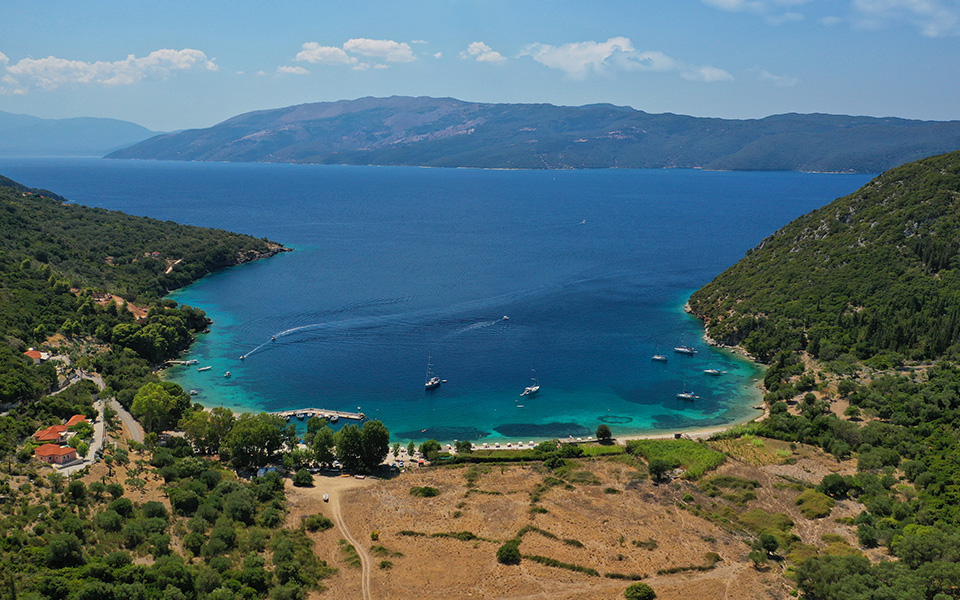
An aerial view of the bay and beach of Polis in northern Ithaki. Loizos' Cave is located in the northwest corner.
© Shutterstock
Location: Northwest corner of Polis Bay
Loizos’ Cave, also known as Polis Cave, is situated on the northwestern side of Polis Bay, a short drive from Stavros village. Extensive excavations conducted by the British School at Athens in the 1930s uncovered a wealth of artifacts, dating from the mid-2nd millennium BC through the Roman period.
Archaeologists believe the cave was an important center for cult activity, with evidence of continuous use from at least the 8th century BC into the period of Roman rule. Among the significant discoveries were a number of Mycenaean (1600-1200 BC) and Early Protogeometric (1070/40-1000 BC) finds, which suggest that the site was an active and thriving place of worship and social gathering for many centuries. Notably, fine Geometric (c. 900-700 BC) bronze tripods were unearthed, along with a fragment of a female theatrical mask inscribed with a votive offering to Odysseus, highlighting the cave’s religious importance.
Although the cave partially collapsed during the 1953 earthquake, its historical significance remains undiminished. The artifacts recovered from Loizos’ Cave are now housed in the Stavros Museum, where they continue to be studied and admired by scholars and visitors alike.
How to Get There: To visit Loizos’ Cave, drive to the northwest corner of Polis Bay (18km north of the island’s capital, Vathy) and follow the signs directing you to the site. The journey provides an opportunity to explore the beautiful surroundings of Polis Bay and enjoy a refreshing dip at the pristine pebbled beach.
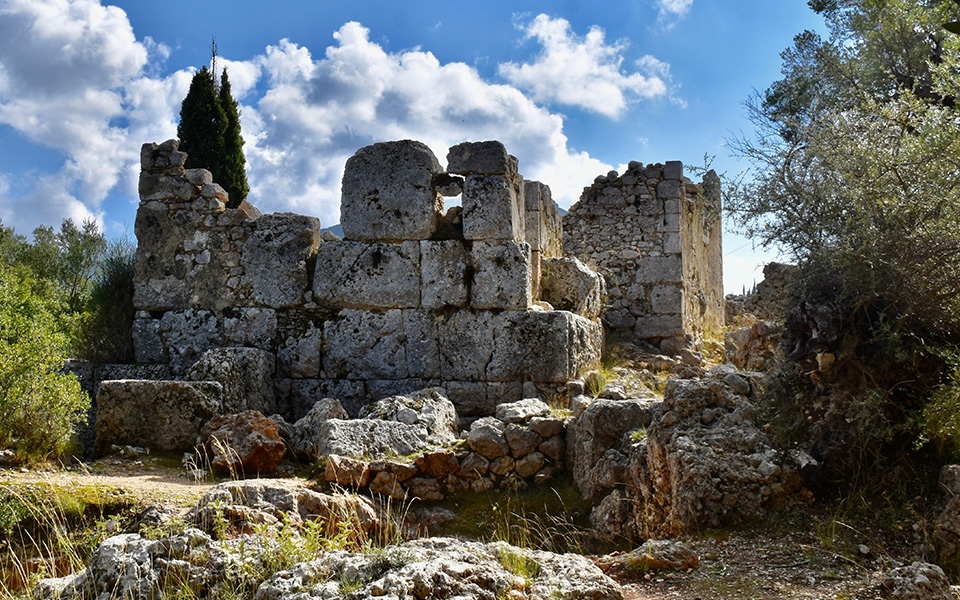
"The School of Homer" - a possible candidate for site of the Odysseus' palace.
© Shutterstock
Location: Eastern slopes of Mount Exoghi, northern Ithaki
The Archaeological Site of Aghios Athanasios, also known as the “School of Homer,” is situated on the eastern slopes of the mountain of Exoghi in northern Ithaki. Excavations led by the University of Ioannina under the direction of Professors Thanasis Papadopoulos and Litsa Kontorli-Papadopoulou have uncovered a significant acropolis-type complex dating back to the Middle Helladic period (1900-1600 BC). This site continued to be in use through the Mycenaean period (1600-1200 BC) and into the Hellenistic period (323-31 BC), highlighting its long-standing historical and cultural importance.
Key features of the site include the ruins of a Hellenistic tower, over which the little church of Aghios Athanasios was erected, as well as a large, three-sectioned rectangular building reminiscent of Mycenaean palaces on the Greek mainland (e.g., Tiryns, Mycenae, Pylos), suggesting it may have served a similar administrative or ceremonial function. Additionally, a subterranean storeroom used for food storage indicates advanced planning and resource management. The site is further fortified by Cyclopean walls of defense, which feature four gates, emphasizing the strategic and protective measures of the ancient inhabitants. A prehistoric well was also uncovered.
In 2010, the site was identified as the possible palace of Odysseus. In a statement at the time, Professor Thanasis Papadopoulos claimed that, “according to the facts as they are presented today, movable or immovable, that are of great significance, with every scientific reservation, we believe that we stand before the palace structure of Odysseus and Penelope, the only palace of the Homeric Epics that has yet to be uncovered.” Although the site is not currently open to the public, efforts are underway for its restoration and preservation, ensuring its stories and artifacts can be appreciated by future generations.
How to Get There: To reach the Archaeological Site of Aghios Athanasios, you can take a track from the Geyfiri Restaurant in the village Platreithias or follow the dirt road from the first bend on the road to Exoghi. While the site awaits restoration, visitors can still explore the surrounding area and imagine the grandeur of this ancient complex.
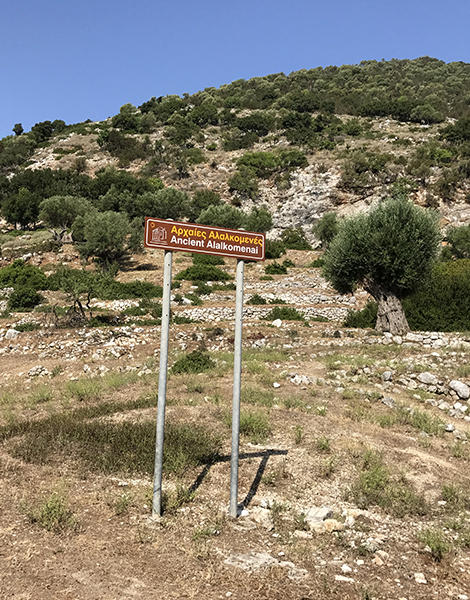
The archaeological site of Ancient Alakomenai
© Shutterstock
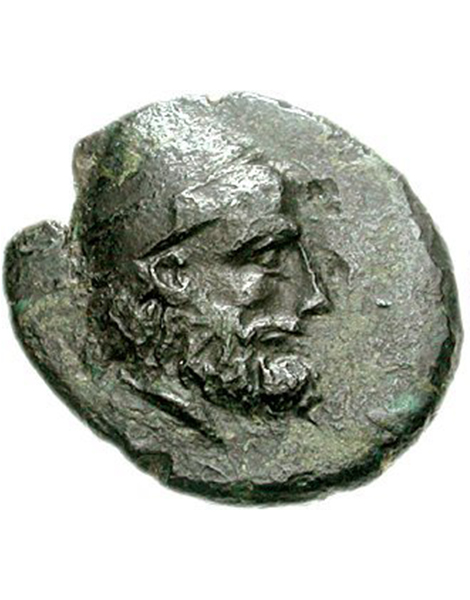
Head of Odysseus wearing a "pileus" cap, depicted on a 3rd-century BC coin from Ithaki.
© http://www.cngcoins.com / Public domain
Location: Slopes of Mount Aetos, overlooking the port of Piso Aetos
Alalkomenes (sometimes spelled “Alakomenai”), an ancient settlement perched on the slopes of Mount Aetos (“Eagle mountain”) in the south of the island, provides a strategic vantage point with sweeping views of the channels between Ithaki and the nearby island of Kefalonia. This site was first identified by early travelers, but it was the excavations conducted by the pioneering 19th century archaeologist Heinrich Schliemann that brought it to prominence. Schliemann’s findings included bronze coins featuring the head of Odysseus and the inscription “Ithakon” (ΙΘΑΚΩΝ), underscoring the site’s historical importance and a tangible link to the Homeric legend.
Further excavations by the British School at Athens uncovered distinctive pottery, indicating that Ithaki had its own production techniques, which were influenced by Mycenaean traditions. Among the most ancient ruins is a circular construction dating back to 1400 BC, which may be linked to a sanctuary dedicated to Apollo, as mentioned in the “Odyssey” (Book 20, 277-278), adding a layer of literary and cultural significance to the site.
Today, visitors can explore the ruins of the Archaic acropolis of Alalkomenes, which date back to the 6th century BC.
How to Get There: To visit Alalkomenes, drive up the slopes of Aetos from Piso Aetos port, the island’s main ferry port, located 7km from Vathy. The journey is relatively straightforward and offers an opportunity to enjoy the scenic landscape of the Aetos region. Once at the site, you can explore the ancient ruins and enjoy the panoramic views that made this settlement such a strategic location in antiquity.
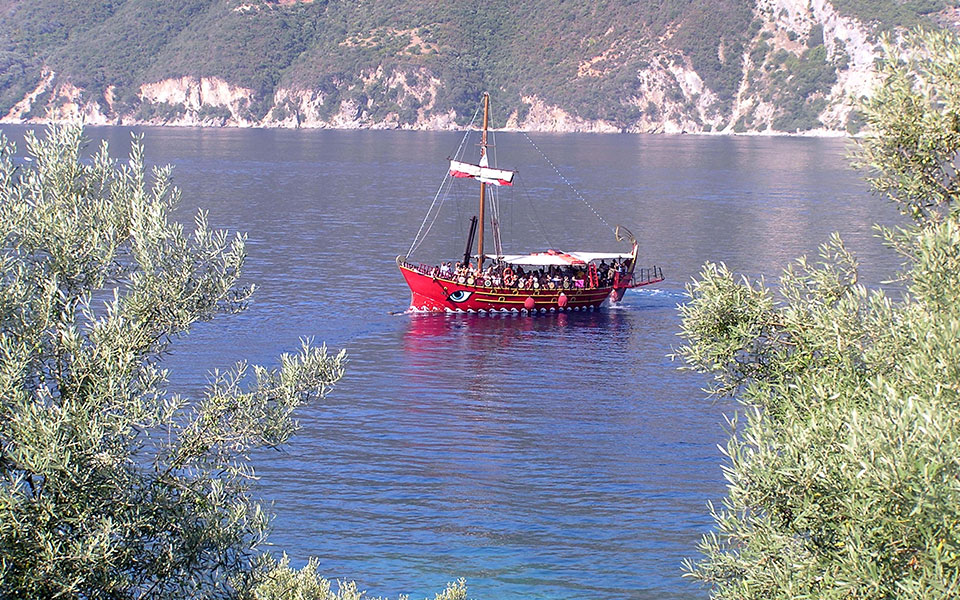
The Nymph's Cave is located above Dexia Beach near Vathy. Here, a fanciful replica of Odysseus' ship takes tourists on a sailing tour of the island's picturesque coastline.
© Shutterstock
Location: Above Dexia (Dexa) Beach, 2km west of Vathy
Marmarospilia, also known as the Nymphs’ Cave, is an ancient site believed to be where Odysseus hid the gifts from Alcinous, King of the Phaeacians. This intriguing cave has been explored by Professor Sarantis Symeonoglou from 1998 to 2001, who uncovered significant artifacts that highlight its historical and religious importance. Much of the cave floor was covered by piles of boulders, a possible indication that the cave was destroyed by an earthquake in 373 BC. Excavations revealed figurines of Nymphs, pots with dedicatory inscriptions, and rings that may have belonged to priestesses, suggesting the cave was a site of worship and ritual.
One of the most fascinating discoveries at Marmarospilia is a deeper cave located beneath the main floor, which reaches a depth of 36 meters. This subterranean chamber revealed bones of sacrificed animals and the entrance to a tunnel, aligning with the description provided in Book 13 of Homer’s “Odyssey.” These findings offer compelling evidence that the site played a significant role in ancient religious practices and mythology.
The nearby beach at Dexia is considered to be the ancient port of Phorcys, the arrival point of Odysseus after his many years of wandering. According to legend, the nearby, small islet of Cazurbo (Skartsoumponisi) is Odysseus’ ship, turned to stone by Poseidon, the god of the sea.
How to Get There: To visit Marmarospilia, drive west from Vathy, following signs to the cave near the main road. While the cave itself is closed, the journey offers a chance to explore the beautiful coastal landscape of Dexia and imagine the return of Odysseus and the rich history hidden within the cave’s depths.
Ithaki is home to two small but interesting archaeological museums that offer a fascinating glimpse into the island’s rich cultural heritage: the Stavros Museum and the Vathy Museum. Both museums are open to the public from Tuesday to Sunday, 08.30 – 15.00, and are closed on Mondays.
For an intriguing alternative theory regarding the modern-day location of Homer’s “Ithaca,” and news of ongoing investigations in search of the Palace of Odysseus, please visit the Odysseus Unbound Project website.
Why not try a brief getaway...
From traditional dances and global rhythms...
Beneath the busy streets of modern...
From epic battles to avant-garde tragedy,...